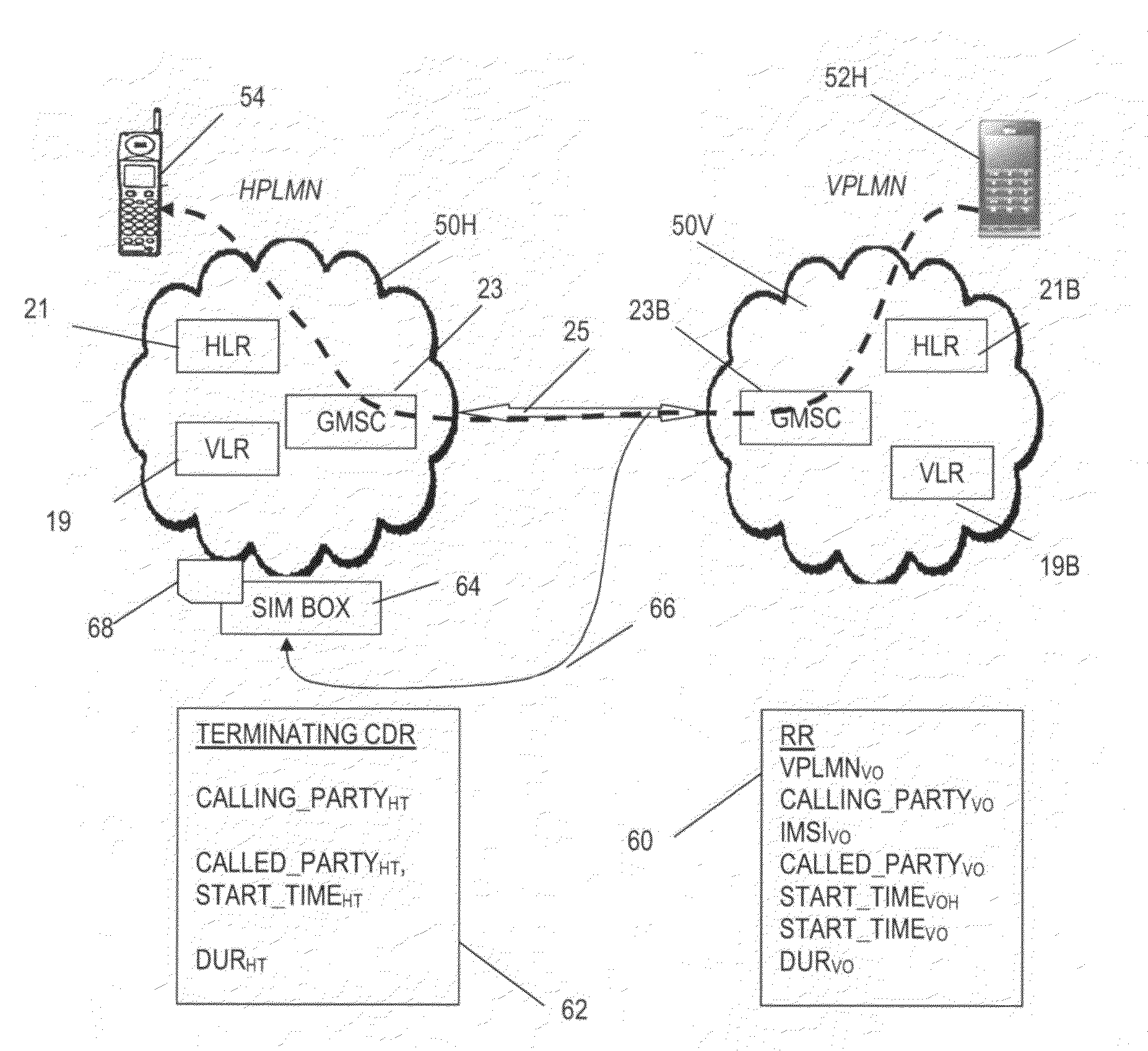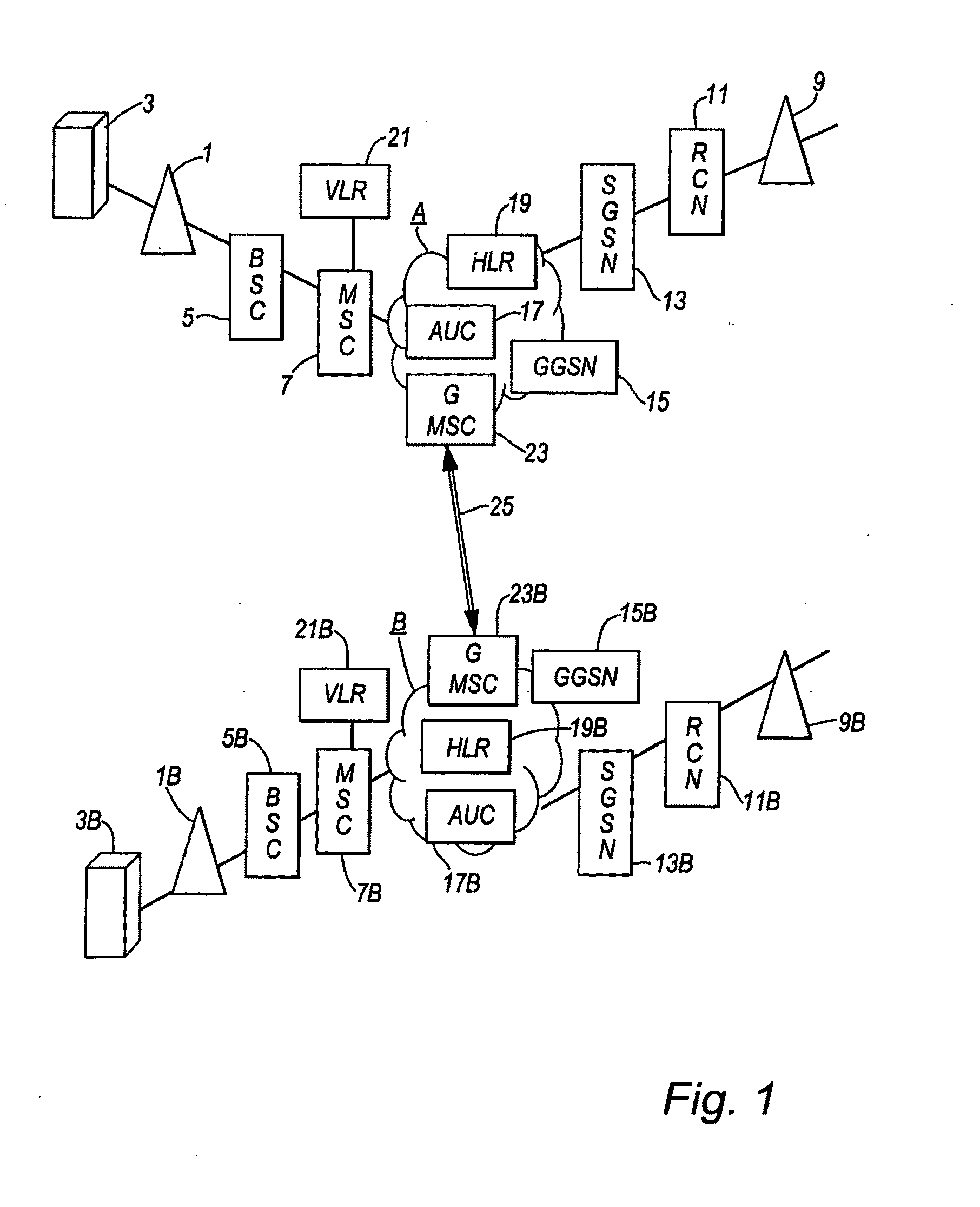Mobile telecommunications network roaming
a mobile telecommunications network and roaming technology, applied in the field of mobile telecommunications systems, can solve the problems of loss of revenue and customer dissatisfaction, and difference between terminating fee and minute fee of sim-box, etc., to facilitate international routing of calls and facilitate the effect of routing
- Summary
- Abstract
- Description
- Claims
- Application Information
AI Technical Summary
Benefits of technology
Problems solved by technology
Method used
Image
Examples
first embodiment
[0072]As shown in FIG. 3, in accordance with the first embodiment, matching of originated call record from the incoming Roaming Record (RR) 60 generated by the VPLMN 50V to the terminating type CDR 62 generated by the HPLMN 50H is performed as described below.
Process I
[0073]For the incoming roaming records (RRs) of the known type described above, the following steps are applied:[0074]Originated RRs destined to the country of the HPLMN 50H are selected, e.g. by matching the country code of the called party 54.[0075]From this selection the following should be excluded[0076]CAMEL roaming related records (since in the case of CAMEL roaming the call establishment and call routing to the called party differs to the normal call routing, the CAMEL roaming case is excluded).[0077]In order to reduce the number of false alarms, records for calls originated to frequently called numbers of the destined country including HPLMN 50H, and to short numbers.[0078]Since the MSISDN in the incoming Roami...
second embodiment
[0133]Referring to FIG. 5, when mobile terminal 54 calls a subscriber mobile terminal 52H of the home mobile network (HPLMN 50H), the call is routed to the HPLMN 50H and this terminates the call to the called party 52H regardless of whether the called party is on the HPLMN 50H or roamed to a visited mobile network VPLMN 50V. The call arrives to the HPLMN of the called party regardless whether or not the call is originated from the HPLMN or from any other domestic or foreign network. If the called subscriber 52H is roamed to a visited network 50H the call is routed by the HPLMN 50H to the VPLMN 50V via international call route 25.
[0134]Usage generated by roamers is charged by VPLMN 50V to HPLMN 50H. Charging is based on TAP files sent by the VPLMN 50V to the HPLMN 50H containing usage details. In order to minimize roaming fraud VPLMN 50V also should send NRTRDE files to the HPLMN 50H. Since only the content of these incoming files and not of their formats is important in connection w...
third embodiment
[0178]As described above, when a caller calls the MSISDN of the mobile terminal 52H (FIG. 6) the call is always initially routed to HPLMN 50H of the mobile terminal 52H. In order to route the incoming call to the called party (e.g. from the mobile terminal 54), the HLR 21 is queried by the (G)MSC 29 of the HPLMN. The HLR 21 knows the address of the VLR 19B with which the roaming terminal 52H is registered. The HLR 21 contacts the VLR 19B for an MSRN that—as a result of the request received from HLR 21—is temporarily allocated to the called mobile terminal 52H by VLR 19B from a technical number range allocated to the VLR 19B by the VPLMN 50V. The temporarily allocated MSRN is sent back to the HLR 19 that gives the MSRN to the (G)MSC 23 to provide the requested routing information. By using the MSRN number the (G)MSC 23 routes the call to the foreign MSC to which the VLR 19B belongs and with which the mobile terminal 52H is registered in VPLMN 50V. The MSRN is transmitted between the ...
PUM
 Login to View More
Login to View More Abstract
Description
Claims
Application Information
 Login to View More
Login to View More - R&D
- Intellectual Property
- Life Sciences
- Materials
- Tech Scout
- Unparalleled Data Quality
- Higher Quality Content
- 60% Fewer Hallucinations
Browse by: Latest US Patents, China's latest patents, Technical Efficacy Thesaurus, Application Domain, Technology Topic, Popular Technical Reports.
© 2025 PatSnap. All rights reserved.Legal|Privacy policy|Modern Slavery Act Transparency Statement|Sitemap|About US| Contact US: help@patsnap.com



